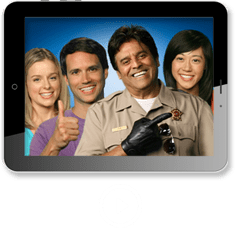How to sign up for traffic school in California – 2024 Guide
Receiving a traffic ticket in California can be a stressful experience, but attending traffic school offers a way to minimize the impact on your driving record and insurance rates.
Whether you’re facing a minor speeding violation or a rolling stop ticket, traffic school can help you avoid points on your license, keep your insurance premiums from skyrocketing, and improve your driving habits. But before you can reap these benefits, you must sign up for traffic school—a process that might initially seem daunting.
Fortunately, with the proper guidance, enrolling in traffic school can be straightforward and stress-free. This step-by-step guide will walk you through everything you need to know, from checking your eligibility to completing the course, ensuring you meet all California-specific requirements.
Step 1: Check Eligibility
- Confirm Eligibility: In California, you may be eligible for traffic school if:
- You have a valid driver’s license.
- The violation is a moving violation (like speeding or running a red light).
- The violation does not involve alcohol or drugs.
- You haven’t attended traffic school for a previous violation within 18 months.
- Note: Some courts in California may not allow traffic school for violations involving more than one point.
- Contact the Court: After receiving a traffic ticket, contact the court listed on the citation to verify eligibility and get approval to attend traffic school.
Step 2: Receive Court Approval
- Court Notification: If eligible, the court will notify you, typically through the citation, of your option to attend traffic school.
- Understand Requirements: Pay close attention to the deadline for completing traffic school, as the court will provide this. In California, you typically have 60-90 days from the court appearance date to complete the course.
Step 3: Select a Traffic School
- Choose a DMV-Approved School: In California, you must attend a traffic school licensed by the California Department of Motor Vehicles (DMV). The court or DMV website provides a list of approved traffic schools.
- Format Options: California allows for different formats, including online courses, in-person classes, and home study programs. Choose the one that best suits your schedule and learning style.
Step 4: Register for Traffic School
- Visit the School’s Website: Go to the website of the DMV-approved traffic school you’ve chosen.
- Sign Up: Provide details such as your name, driver’s license number, citation number, and the court handling your case.
- Pay the Fee: The cost of traffic school in California varies, but expect to pay between $20 to $45, depending on the school and course format.
Step 5: Complete the Traffic School Course
- Study the Material: If you are taking the course online, you can complete it at your own pace or attend the scheduled in-person sessions.
- Pass the Exam: At the end of the course, you’ll need to pass a final exam. A passing score is generally required in California to receive your completion certificate.
Step 6: Submit Completion Certificate
- Electronic Submission: Many DMV-approved schools in California will electronically submit your completion to the court. Confirm this with the school during registration.
- Follow-Up: If electronic submission isn’t available, submit the certificate before the court’s deadline.
Step 7: Verify Completion
- Check Court Records: Follow up with the court to ensure they have received your completion certificate and have processed it accordingly.
- Retain Documentation: Keep a copy of your completion certificate and any court correspondence for your records.
Step 8: Monitor Your Driving Record
- Verify Point Dismissal: After completing traffic school in California, the violation should not add points to your driving record. Check your driving record with the DMV to ensure this has been processed.
- Confirm Insurance Impact: Confirm with your insurance company that the completion of traffic school has been noted, preventing any potential increase in your insurance rates.
This guide is specific to California and reflects the current DMV and court policies as of the latest updates. Make sure to follow any additional instructions provided by your local court.
How to Schedule Traffic School in California?
Scheduling traffic school in California is crucial once you’ve determined your eligibility. After receiving court approval, you must select a traffic school licensed by the California DMV. You can choose the format that best suits your needs with a wide variety of options available, including online courses and in-person classes.
Once you’ve selected your preferred traffic school, scheduling is as simple as visiting the school’s website or contacting them directly to register.
Be sure to consider your court-imposed deadline and choose a course that allows you enough time to complete it before the deadline. Most schools offer flexible scheduling, allowing you to start the course immediately or at a time that fits your schedule.
How Much is Traffic School in California?
The cost of attending traffic school in California can vary depending on your chosen school and the course format. On average, you can expect to pay between $20 and $45 for the course.
In addition to the course fee, California courts typically charge a separate administrative fee when you opt for traffic school, ranging from $50 to $64.
This fee is usually paid directly to the court when you request permission to attend traffic school. Budgeting for both the course and administrative fees is essential, as the total cost of completing traffic school in California can range from $70 to over $100.
Physically Attending Traffic School or Completing Traffic School Online
When it comes to fulfilling your traffic school requirements in California, you have the option to choose between physically attending a traffic school or completing the course online. In-person classes provide a traditional classroom where you can interact with an instructor and fellow attendees. It is a good option if you prefer a structured environment or live instruction.
However, these classes may have set schedules that you need to work around.
On the other hand, online traffic school offers the convenience of completing the course at your own pace, from the comfort of your home or anywhere with an internet connection. This flexibility makes online courses popular for those with busy schedules or who prefer to study independently. The California DMV equally recognizes both options, so you can choose the format that best suits your learning style and schedule.
Enrolling in traffic school in California is a practical step to protect your driving record and keep your insurance rates in check. Following the outlined steps, you can easily navigate the process and complete the course on time. Whether you attend in person or online, traffic school offers a valuable opportunity to improve your driving skills and maintain a clean record.




